While the Netherlands reached the quarter-finals in the 2022 FIFA World Cup, they have not reached the same round in the UEFA European Championships since 2008 – they failed to earn qualification at all for the 2016 Euros and were dumped out at the round of 16 in the 2020 edition of the tournament.
The only European trophy for the Netherlands came in 1988, where they defeated the Soviet Union 2-0 in Munich.
So, you would think that the Dutch will be on a serious mission to replicate the success of ‘88 this time around, especially with the quality that runs throughout the current crop of players.
Ronald Koeman is the current boss, with the Dutch legend being in charge of the side for the second time – his first stint came back between 2018-2020, where he took charge of 20 games for the national side.
He has won seven of his 12 games in his second reign thus far.
Koeman’s current side earned qualification to this year’s Euros by finishing second in their qualifying group, behind France — who they also share a place within Group D in the tournament this summer.
Six wins from eight (both defeats coming against France) and 17 goals scored, seven conceded isn’t too prolific, but it got the job done.
Their struggle against France over both games may be a cause for concern going into the finals this summer.
In this preview, we will provide a tactical analysis of the Netherlands, examining what their tactics in and out of possession are likely to look like and also discussing squad selection in this analysis.
Netherlands Predicted starting XI
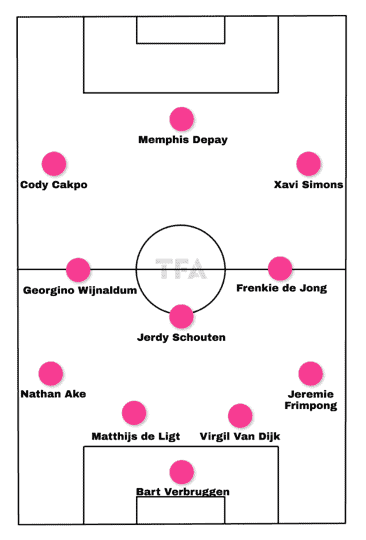
Multiple high-profile names are expected to don the Dutch orange this summer, with 4-3-3 being the likely shape that Koeman’s side take.
Oranje have deployed this formation more often than not in the past year, but they do have alternative options – 3-4-3/3-4-2-1 is also a possibility, as we’ve seen Holland lineup this way fairly regularly too, including in their most recent friendly against Germany.
However, the above graphic shows us what we are most likely to see this summer.
In terms of personnel, there are a few names are pretty much nailed on for a starting spot, barring injury or some other circumstance.
Virgil van Dijk, Frenkie de Jong, and Bart Verbruggen are three names that will likely be ever-present in the tournament – Koeman does have the luxury of strong squad depth in every position.
Hence, there are a few names that could come into the fold that aren’t in our predicted lineup above.
Wout Weghorst has been in and around the setup for years now, including recent fixtures, and could be preferred to Memphis Depay if a more physical and direct approach is required in attack.
Xavi Simons in that right-wing slot may surprise a few – he did feature there in a recent fixture against Scotland, and given his strong club form this season while on loan at Bundesliga club RB Leipzig, Koeman may be keen to include Simons anyway he can.
That being said, the PSG man is able to play in several different roles across the front line and midfield.
The back four, particularly that left side, could take a few different forms.
Nathan Ake could take up a centre-back role, opening up the chance for another left-back to come into the fold.
In front of the back four, it is highly likely that Jerdy Schouten will consistently present to offer that defensive protection as the anchor of the three-man midfield.
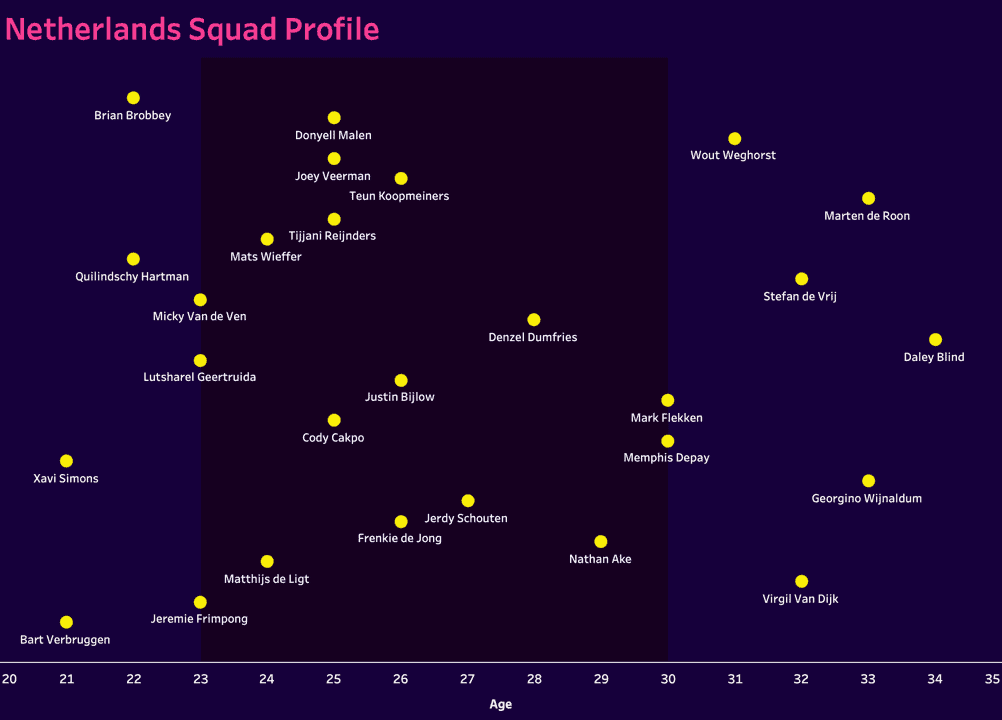
As the graph above shows us, this Dutch side has a strong blend of youth and experience dotted throughout the squad.
Do note there are a few names included above that have not made the 30-man provisional squad, and with that comes some names that are missing from the graphic – goalkeeper Nick Olij (28, Sparta Rotterdam), Steven Bergwijn (26, Ajax), Ryan Gravenberch (22, Liverpool), Ian Maatsen (22, Dortmund), and Quinten Timber (22, Feyenoord).
All of these are somewhat surprise inclusions as they have not been present in any of the squads for well over a year.
Timber, who has featured in the previous two games, is the exception to that notion.
Experience comes in the form of names like Daley Blind, van Dijk, Georginio Wijnaldum, and Depay, to name but a few.
Eight players ages 30+ are included in the provisional squad.
Plenty of exciting names are in their prime, and the under-25 bracket, in particular, contains players who could leave a real mark on the competition.
Netherlands Attacking Phase
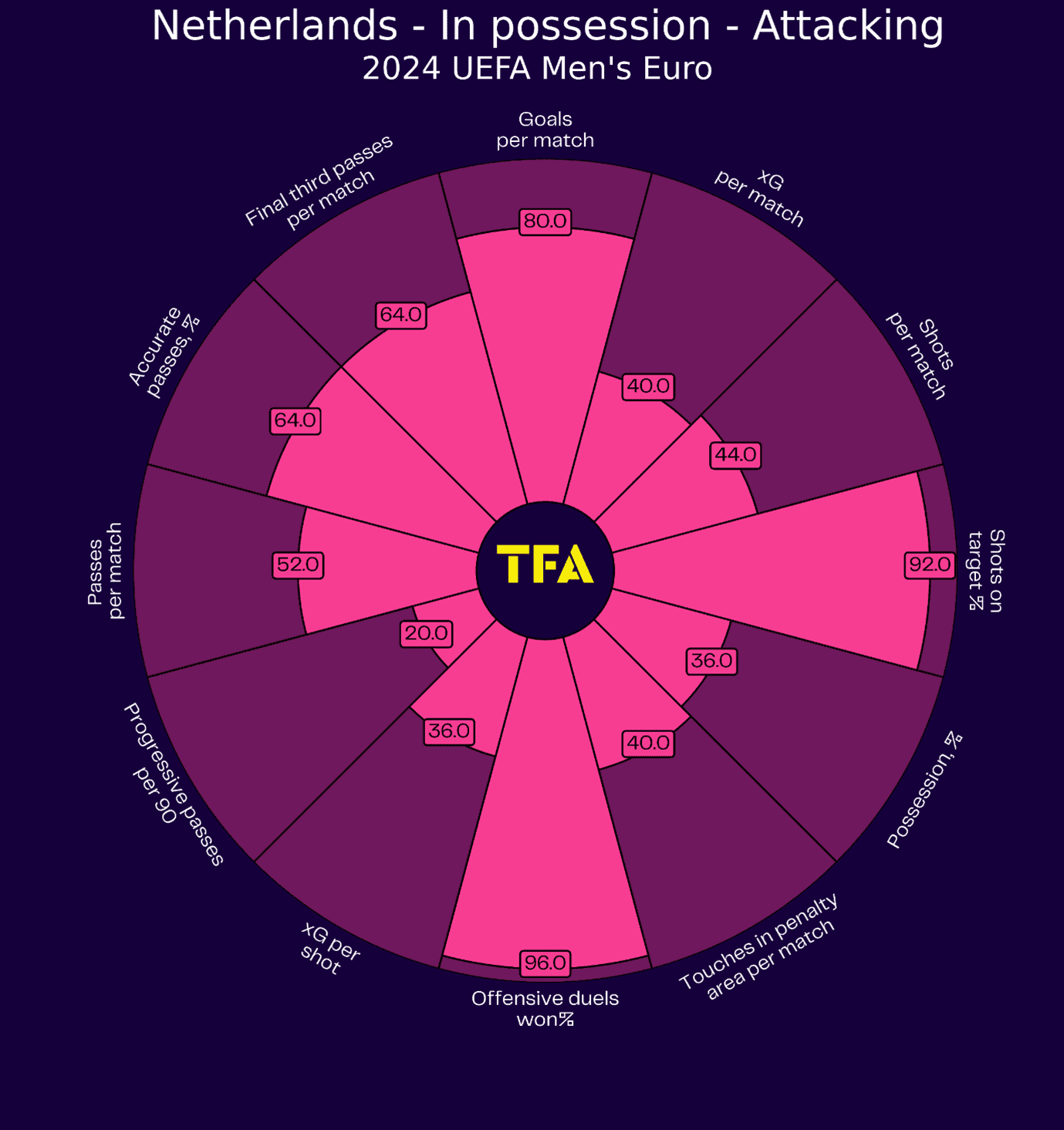
We can expect to see a clinical display from the Dutch in attack this summer if the data above is to be replicated.
Koeman’s side produce high percentile rankings for shots on target and goals while also showing an individual ability when it comes to offensive duels.
When it comes to attacking tactics, we shouldn’t expect to see a purely possession-based approach unless they’re facing a team that is extremely defensive and prefers a low block.
With Poland, Austria, and France in their group, it’s unlikely that they face that scenario.
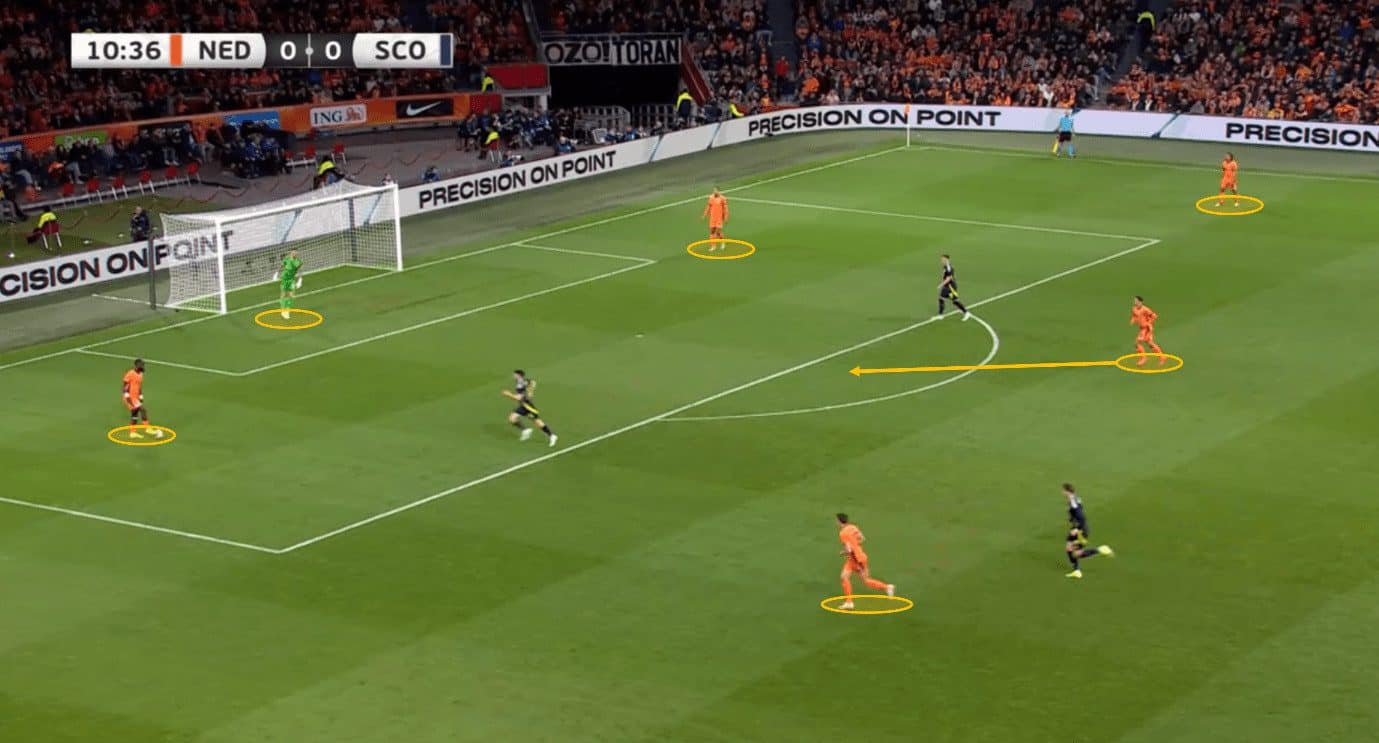
A lack of consistent possession does not mean they’ll play a long-ball game.
While direct passes into target man Weghorst, or the pacey options on either flank, can be more than useful for Koeman’s tactics, the Netherlands still want to utilise the ball on the ground, often playing out from back, even in deeper areas.
Their 4-3-3 allows for the back four to spread wide, while the fluidity and versatility in midfield can give them good options to play into.
While they obviously want to progress up the pitch where possible by playing through the opponent this way, the aim with these tactics is to draw the opponent out – invite that pressure to create higher-up space, which we see panning out in the following image.
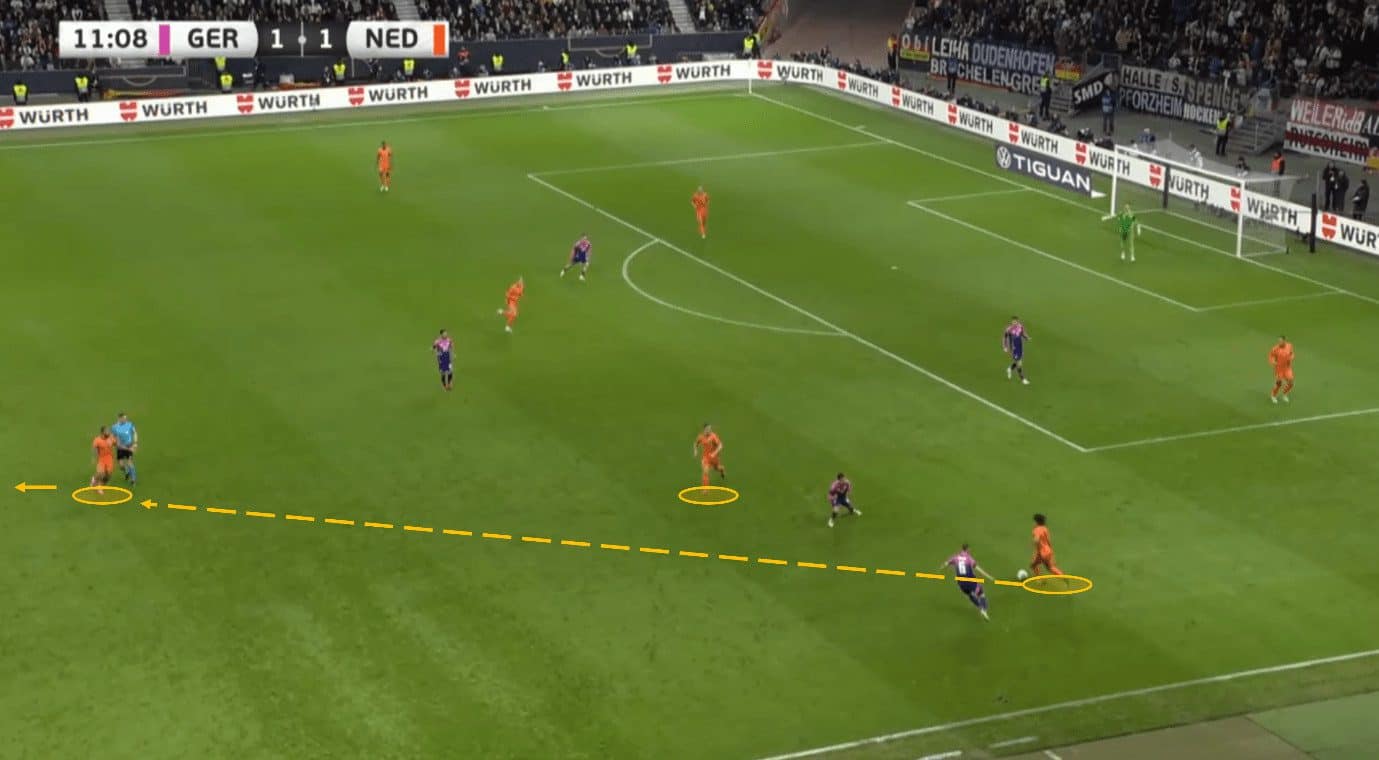
As you can guess from the shape of the back four of the Dutch side in this example, they still looked to play out from the back in a deeper area, inviting on pressure from the opposition.
They often look for an opportunity to break into the midfield third, and with the opposition lured into the high press, there is often space to exploit that third, with at least two midfielders often looking to act as passing outlets from the back.
One thing we know this Dutch squad has is pace and athleticism, which comes in handy when receiving the ball in these situations, as a midfielder can carry the ball forward quickly.
Alternatively, particularly when the defensive line has possession higher in their own half, a line-breaking pass into the CF can be expected with an aim to move the ball into a more advanced area quickly.
In the final third, quick combinations and/or clever and subtle off-the-ball movements are essential as Holland looks to work the ball into exploitable spaces between the full-back and centre-back before setting up a chance on goal.
Of course, attacking on the break and in transitions is an important feature in Koeman’s tactics.
Netherlands Defensive Phase
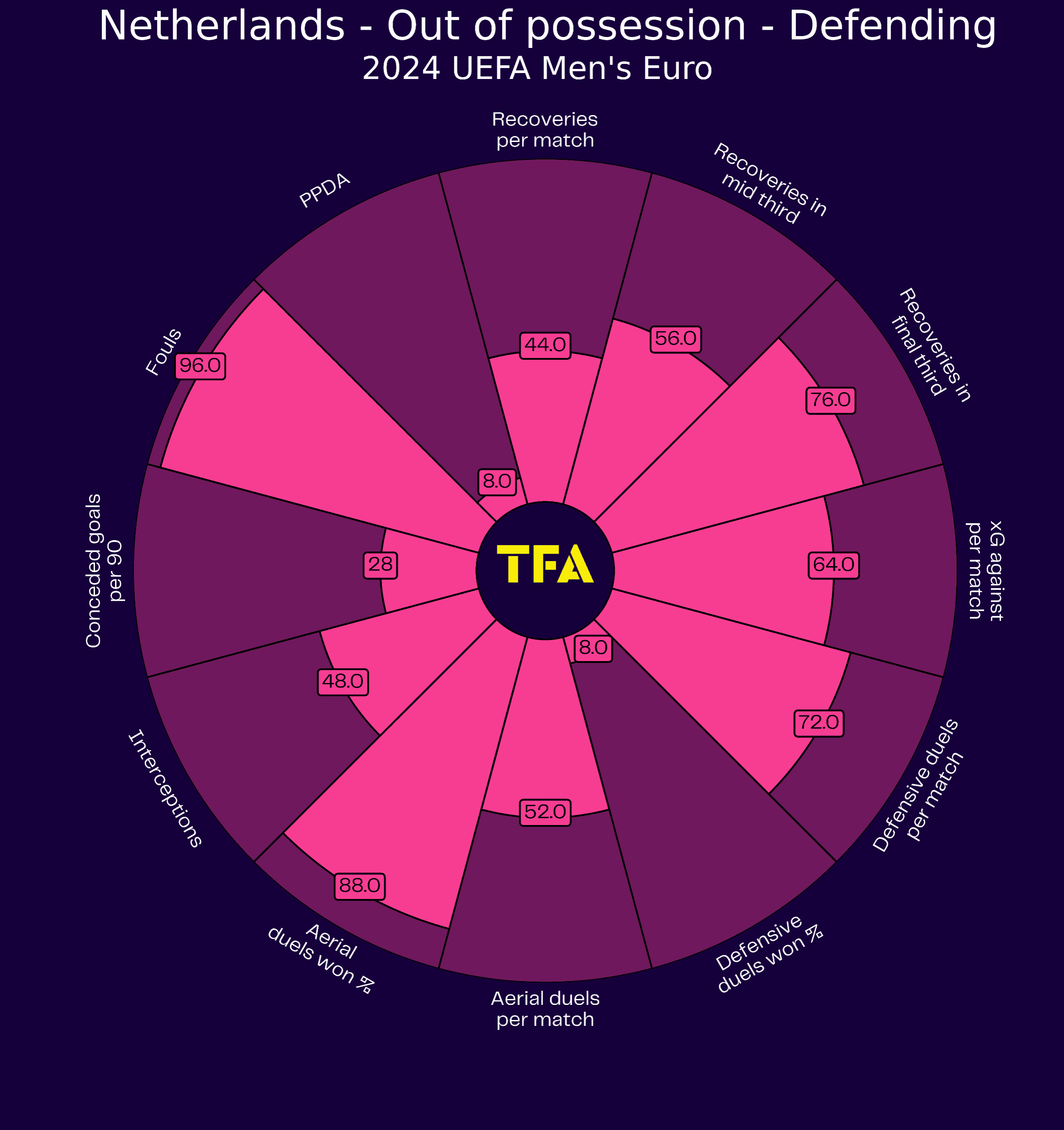
Expect a certain level of aggression from the Netherlands this summer, but not in terms of their press.
As you can see, they rank high for fouls made – something they will definitely want to keep a lid on this summer to avoid giving away dangerous free kicks and penalties.
When it comes to their actual tactical approach, expect to see a well-structured, compact mid-block with specific pressing triggers.
They are usually patient when it comes to pressing, as evidenced by their PPDA of 13.49 in the past year.
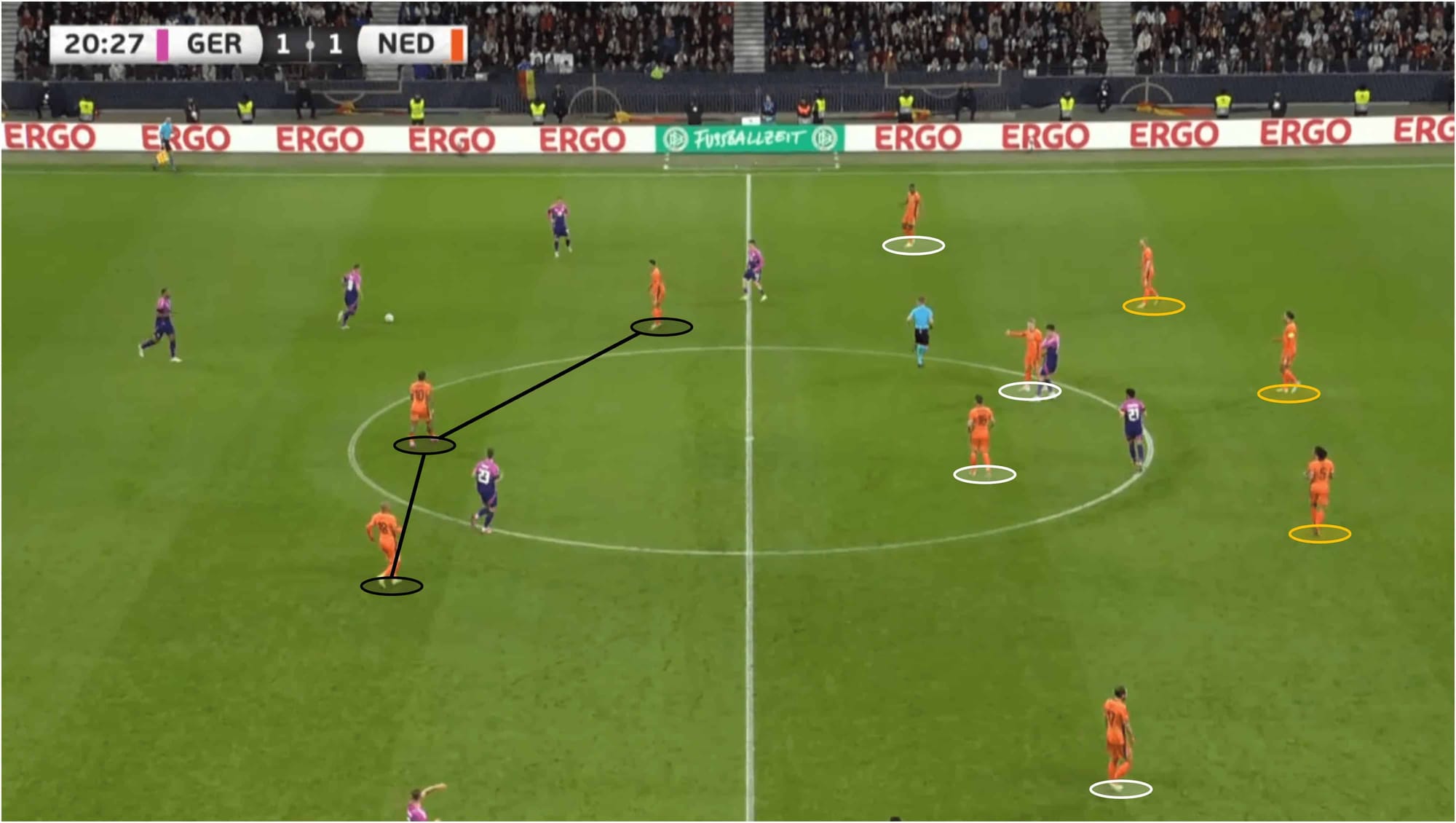
Above is an example of Holland’s aforementioned mid-block.
It is worth noting that in this game, they operated in a 3-4-3, but the tactics and principles remained the same.
The back line is to be positioned fairly high, with the midfield unit not too far in front of them but spaced a bit wider apart.
The aim here is to protect the central area between the midfield and defence, and with a strong numerical presence on hand, if a pass does get played into that area, Oranje will be ready to swarm the ball and try to win it back quickly.
The front three tend to sit back slightly, usually quite narrow, as you can see above, operating to a similar purpose as the midfield, only, of course, higher up the pitch.
The wingers being narrow as to marking the full-backs, for example, adds to that central defensive structure, which can also provide a useful presence in the event of a transition.
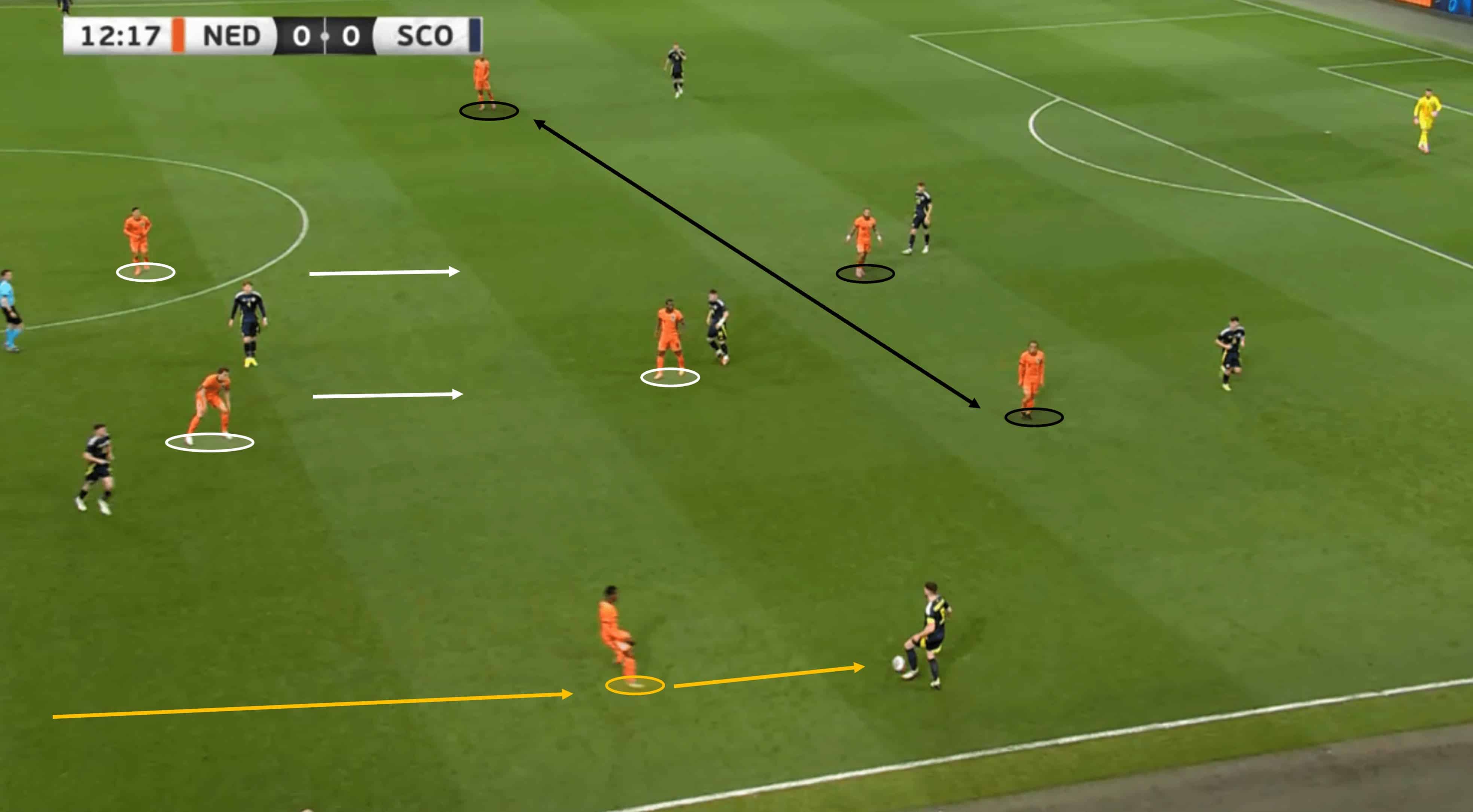
As we mentioned earlier, the Dutch will look to press, but timing is vital for them.
As the stats suggest, they remain fairly patient as they wait for the right moment to squeeze the pitch and commit bodies forward into duel scenarios.
One of the primary triggers for this is a backward pass and/or a decrease in the opposition’s possession tempo—it’s like the Dutch see that as a weakness and look to capitalise.
Notice – the front three gain more width between them when higher up the pitch, with the full-back charging up the field to press the ball.
As for the midfield, they tend flip their original shape, allowing for a more advanced midfielder who often has the task of marking a nearby opponent.
The two deeper midfielders also gain yards up the pitch, continuing that theme of defending areas in central midfield.
Netherlands Transitions
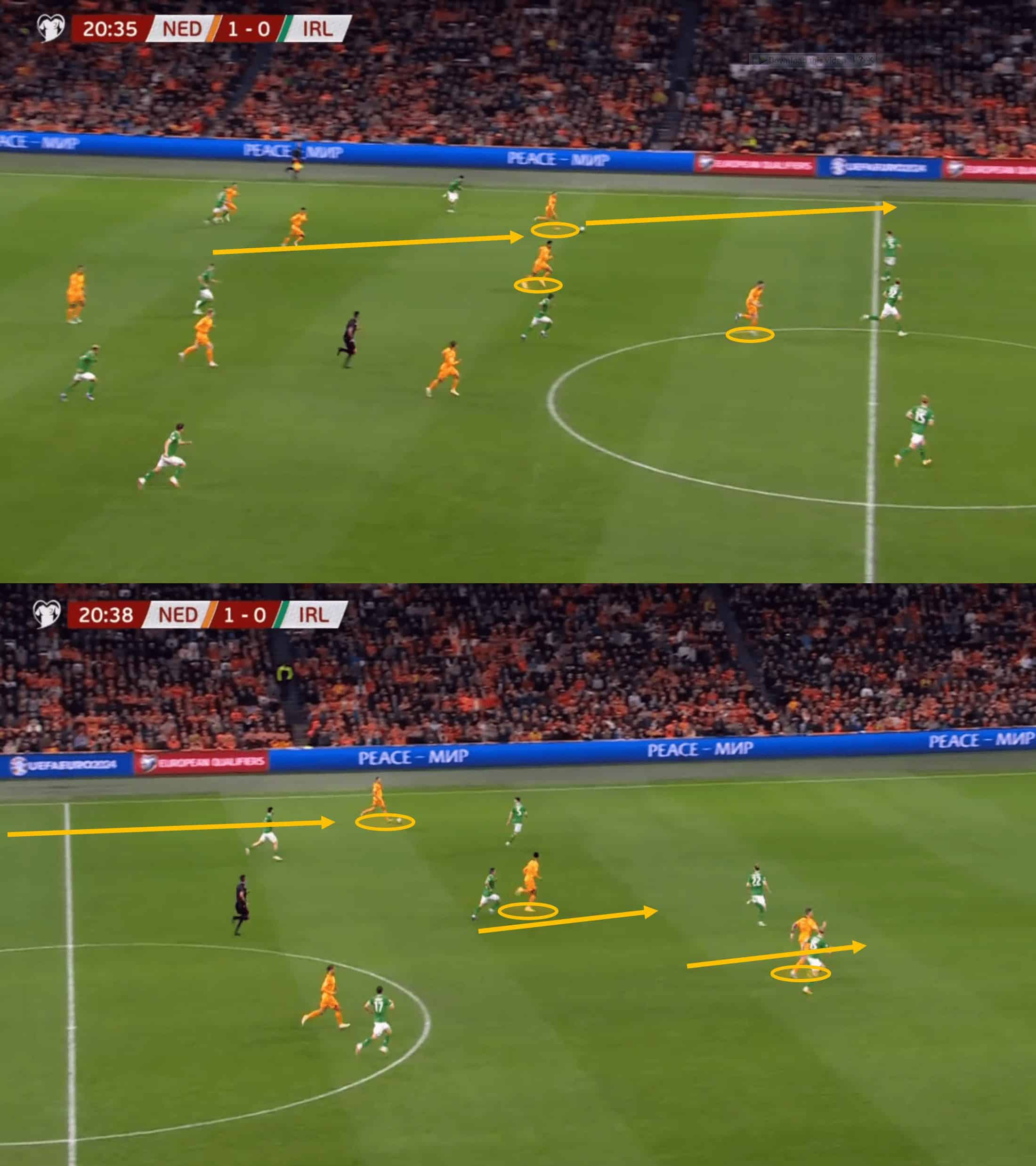
In the event of a transition in Holland’s favour, they will often look to break forward quickly – the number of immediate forward runners depends on several game-related factors, but don’t be surprised to see at least three runners if they win the ball back in midfield.
The above image shows a good example of the Dutch looking to get up the field quickly but not carrying out a pure counterattack.
Daley Blind won the ball in his own half after leaving the back line to engage in a duel.
The veteran proceeded to carry the ball well into the midfield third and noticed the forward runs from attacking teammates, as mentioned.
His next action brings up an interesting theme of different uses of breaking forward via transition.
Sure, sometimes they look to launch a counterattack and hit the opposition while they’re more vulnerable, but sometimes, like the example above, they use transitions to get up the pitch and then slow play down.
This allows the team as a unit to get up the pitch and for the team to get a firm grip on possession to dictate this moment of play.
Netherlands Forwards
Earlier on, we spoke of Ronald Koeman’s options for central attack – namely, the healthy competition between Weghorst and Depay.
They do, however, have other options within the squad.
Of course, Liverpool’s Cody Gakpo could be asked to play a central role instead of playing on the left, while Brian Brobbey and Donyell Malen both firepower to the squad, with the latter also able to play on the flank.
Xavi Simons would be another option in that role if necessary or if Koeman opts for a tactical change requiring a more tactically capable presence up top.
Back to the debate of Weghorst vs Depay.
Obviously, there are two very different forwards, and that’s the beauty of it – that is the sort of selection headache managers dream of.
While Manchester United fans may still have a bitter taste in their mouth about Weghorst’s time at Old Trafford, the big forward still has a lot to offer if the tactical setup suits him.
But does he push Memphis Depay out of the starting 11?
Probably not.
While Weghorst does offer good ability in build-up play, not to mention the ability to hold the ball up and win a variety of duels, Depay’s mobility and athleticism lends itself to Holland’s primary attacking tactics – his ability to link up with wide players in the final third can also cause problems for the opposition.
His goalscoring record has not been admirable this season, though; the same can be said of Weghorst.
In terms of wide attacking options outside of the three stated in the lineup earlier on, Steven Bergwijn, who, to be fair, has a good chance of starting, is in the provisional squad.
Depay can operate on the left if tasked, while Jeremie Frimpong would also take on the role of attacking winger.
Midfielders
Koeman opted not to include Mats Weiffer, as the Feyenoord midfielder is only just returning from an injury.
This will come as a disappointment for the Netherlands as the strong midfielder has been an important player for them in multiple fixtures in the past year.
Their defensive midfield role is safe hands, though, as Jerdy Schouten is likely to play that anchor role – another critical player in recent fixtures.
Veteran Marten de Roon is another solid option for that defensive midfield role.
Elsewhere in the battle for midfield starting places, Wijnaldum’s presence in midfield brings all sorts of bonuses, but at the age of 33, questions surround his ability to be consistently available this summer.
A few midfielders will be ready to step into that lineup – the versatile Xavi Simons is one option, as is Tijjani Reijnders, but perhaps the player most likely to feature ahead of Wijnaldum is Teun Koopmeiners.
The Atalanta midfielder, who has recently been linked with a move to Liverpool, brings a range of abilities to midfield.
While he’s less likely to carry the ball forward like Wijnaldum is known for, his defensive ability and footballing IQ are seriously impressive.
Despite the lack of dribbles, his technical ability should not be frowned upon, as evidenced by his passing percentiles.
Defenders
Another player who has missed out on a spot in the squad due to injury issues is left-back Quilindschy Hartman.
The 22-year-old has recently featured and impressed regularly for the national side, so you can imagine that if he were fit, he’d be on that plane.
Manchester City’s Nathan Ake will likely take the left-back spot – Daley Blind is another option.
At right-back, Leverkusen’s Jeremie Frimpong has been seriously impressive this season, which led to his first senior international cap last October.
We believe he will be the first choice in that position this summer, but Inter’s versatile Denzel Dumfries offers strong competition – his experience is exceptional, too, with 51 senior caps under his belt.
23-year-old Lutsharel Geertruida, yet another Dutch player being linked to join Arne Slot’s Liverpool era, is another option at right-back.
But he also has good experience at centre-back, for club and country: he, in fact, played that role recently against Scotland.
Another player who lacks international experience, something that Koeman is clearly a fan of, could still challenge for that starting spot next to van Dijk.
Stefan de Vrij and Matthijs de Ligt are his bigger competitors for that role.
The latter offers more of a ball-playing defender role and has shown consistency in bringing the ball out of defence.
It is worth bearing in mind that Geertruida will show similar qualities in his experience at right-back, though.
The younger defender has also offered better percentiles in multiple defensive KPIs and brings more of an aerial presence.
Key player
Some obvious names will spring to mind when you think about which player will be pivotal to any success the Netherlands have in the Euros this year – van Dijk and de Jong, for example, will be critical.
One player, though, who has had a blinding season at club level and could use this tournament as a chance to springboard into stardom is Bayern Leverkusen’s Jeremie Frimpong, who is likely to be the starter at right-back for Oranje this summer.
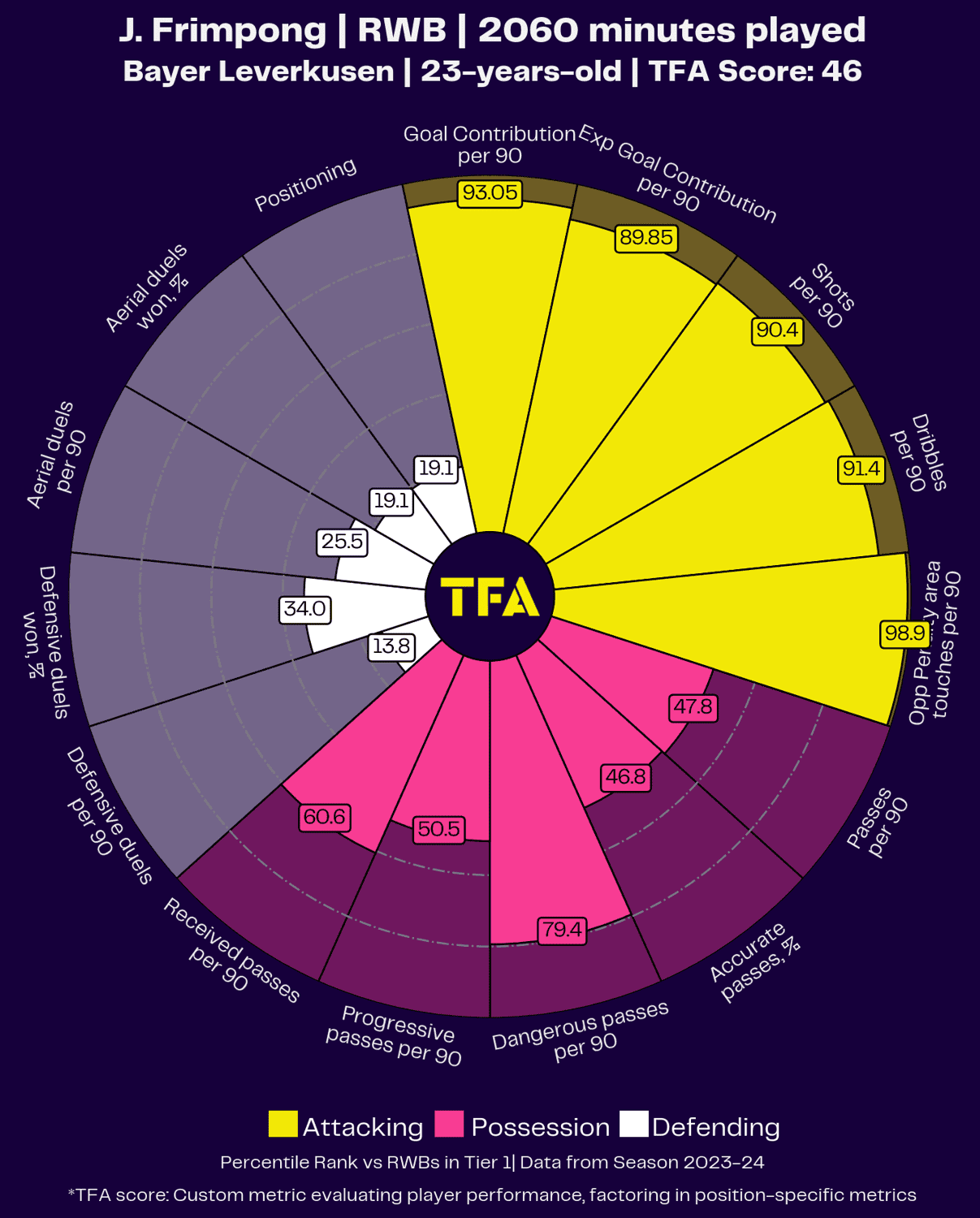
In case you don’t know, Frimpong has played a crucial role in Leverkusen’s record-breaking season, operating in a right wing-back role.
As you can tell from the graphic above, that role holds plenty of attacking responsibility.
His tendency to carry the ball forward, utilising his pace in possession while also possessing decent creative ability from that wide position, could pair well with the Netherlands’ tempo in certain attacking areas.
While inexperienced at an international level, Frimpong’s exciting attacking style could be a key area for the Netherlands from an attacking viewpoint.
Tournament prediction
The Netherlands face a tricky group phase – France are the bookies’ second favourites to claim glory, so topping Group D is a challenge in itself.
Of course, these types of odds mean very little once the kick-off is taken, but there is quality in this Dutch team to be something of a surprise package.
France, Poland, and Austria will share Group D with Holland, so Koeman will be both wary of producing solid performances against the latter two nations to consolidate second place but also confident of progressing to the knockout rounds.
Finding the balance there is important as neither Poland nor Austria are to be overlooked in terms of giving Holland one hell of a fight.
Should they progress from the group phase as expected, a run to the quarter-final is likely a realistic shout for this Dutch side, but don’t be too surprised if they go on further and reach the final four.





Comments